Overview of Gas-Generating-Reaction-Based Immunoassays
Abstract
1. Introduction
2. Types of Gas-Generating Reactions
3. Distance-Based Readout
3.1. Chip-Based Immunoassays
3.2. Capillary-Based Immunoassays
3.3. Others
| Signal Label | Target | Linear Range | Detection Limit | Ref. |
|---|---|---|---|---|
| PtNPs | cTnI, CK-MB, Myo | 0–25 ng/mL, 0–33 ng/mL, 0–250 ng/mL | 0.014 ng/mL, 0.16 ng/mL, 0.85 ng/mL | [14] |
| PtNPs/SiO2 | AFP | 0.05−132 ng/mL | 16 pg/mL | [15] |
| Catalase | CRP | 200−2000 ng/mL | 200 ng/mL | [19] |
| PtNPs | CEA | 7.81−500 pg/mL | 0.6 pg/mL | [21] |
| PtNFs | E. coli O157:H7, S. typhimurium | 102–104 CFU/mL, 10–105 CFU/mL | 15 CFU/mL, 7 CFU/mL | [39] |
| Au@PtNPs | CRP | 0.05–6.25 ng/mL | 41 pg/mL | [40] |
| Catalase/SiNPs | S. typhimurium | 10–104 CFU | 10 CFU | [43] |
| Catalase | S. typhimurium | 5 × 102–5 × 104 CFU | 1.6 CFU | [44] |
| Catalase | S. typhimurium | 102–106 CFU/mL | 150 CFU/mL | [49] |
| HRP | hCG | Not reported | 1.4 ng/mL | [50] |
| PtNPs | TnI | 0.1–100 ng/mL | 0.1 ng/mL | [59] |
| PtNPs | BNP | 4.6–404.7 pM | 6 pM | [60] |
| PtNPs | CEA | Not reported | 10 pg/mL | [61] |
| PtNPs | CRP | 25–100 ng/mL | 25 ng/mL | [62] |
| PtNPs | PSA | 0–12 ng/mL | 0.54 ng/mL | [63] |
| PtNPs | CYFRA 21-1 | 0.5–50 ng/mL | 0.5 ng/mL | [66] |
| PB NPs | PSA | 2−64 ng/mL | 2 ng/mL | [68] |
| Fe3O4/PB NPs | PSA | 0−64 ng/mL | 2.1 ng/mL | [69] |
| Pt@AuNPs | PSA, CEA | 0.02−2.5 ng/mL, 0.063−16 ng/mL | 17 pg/mL, 44 pg/mL | [71] |
| Catalase@AuNPs | E. coliO157:H7 | 102–107 CFU/mL | 80 cfu/mL | [72] |
| HRP/TMB | CEA | 0−20 ng/mL | 78 pg/mL | [73] |
| CuO NPs | Silk fibroin | 10−105 ng/mL | 10.58 ng/mL | [75] |
| MnO2 NFs | E. coli O157:H7 | 10–105 CFU/mL | 10 CFU/mL | [76] |
| CeO2@Pt/AuNPs | Aminopyrine | 0.001−10 ng/mL | 0.41 pg/mL | [77] |
| Au@PtNPs | E. coli O157:H7 | 1.19 × 103–1.19 × 107 CFU/mL | 216 CFU/mL | [78] |
4. Pressure Differential


| Signal Label | Target | Linear Range | Detection Limit | Ref. |
|---|---|---|---|---|
| PtNPs | Myo | 2.9–75 ng/mL | 2.9 ng/mL | [87] |
| PtNPs | Myo | 0–100 ng/mL | 0.26 ng/mL | [88] |
| PtNPs | sHER-2 ECD | 2–50 ng/mL | 2 ng/mL | [90] |
| PtNPs@Cu3(PO4)2 | E. coli O157:H7 | 10–104 CFU/mL | 10 CFU/mL | [91] |
| Catalase | CRP | 10–50 nM | 1.8 nM | [93] |
| Pt/SiO2 NSs | AFP | 10–200 ng/mL | 3.4 ng/mL | [94] |
| PtNPs | CRP | 5–400 ng/mL | 1.6 ng/mL | [95] |
| Au@PtNPs | CEA | 0.025−1.6 ng/mL | 21 pg/mL | [96] |
| PdCuPt NPs | ICP, CAB | 0.02−50 ng/mL, 0.15−50 ng/mL | 6.7 and 30.2 pg/mL | [99] |
| DPNs | AFB1 | 0.05–10 ng mL | 30 pg/mL | [100] |
| PtNPs | CEA | 0.2–1000 ng/mL | 0.14 ng/mL | [102] |
| PtNPs | CEA | 0.1−40 ng/mL | 87 pg/mL | [103] |
| PtNPs | CEA | 0.2–60 ng/mL | 0.13 ng/mL | [104] |
| PtNPs | PSA | 0.02–50 ng/mL | 12.6 pg/mL | [105] |
| Catalase | PSA | 0.1–50 ng/mL | 57 pg/mL | [106] |
| PtNPs | CEA | 0.5−60 ng/mL | 167 pg/mL | [107] |
| Au@AgPtNPs | H5N1 | 0–3 ng/mL | 15 and 65 pg/mL | [109] |
| Pt@MnO2 NFs | Salmonella | 1.5 × 10–1.5 × 105 CFU/mL | 13 CFU/m | [112] |
| PtNPs | Myo | 6.67–150 ng/mL | 3.82 ng/mL | [110] |
| SiC-CS@Ag | E6 protein | 10−6–1 ng/mL | 1.6 fg/mL | [115] |
| Nb2C MXene | IL-6 | 10−5 to 1 ng/mL | 3.33 × 10−6 ng/mL | [116] |
| PtNPs | CEA | 0.1–90 ng/mL | 81 pg/mL | [117] |
5. Visualized Detection
6. Thermal Measurement
7. Conclusions and Perspectives
Author Contributions
Funding
Institutional Review Board Statement
Informed Consent Statement
Data Availability Statement
Conflicts of Interest
References
- Zhao, Q.; Lu, D.; Zhang, G.; Zhang, D.; Shi, X. Recent improvements in enzyme-linked immunosorbent assays based on nanomaterials. Talanta 2021, 223, 121722. [Google Scholar] [CrossRef] [PubMed]
- Farka, Z.; Juřík, T.; Kovář, D.; Trnková, L.; Skládal, P. Nanoparticle-based immunochemical biosensors and assays: Recent advances and challenges. Chem. Rev. 2017, 117, 9973–10042. [Google Scholar] [CrossRef] [PubMed]
- Liu, L.; Hao, Y.; Deng, D.; Xia, N. Nanomaterials-based colorimetric immunoassays. Nanomaterials 2019, 9, 316. [Google Scholar] [CrossRef] [PubMed]
- Liu, L.; Chang, Y.; Lou, J.; Zhang, S.; Yi, X. Overview on the development of alkaline-phosphatase-linked optical immunoassays. Molecules 2023, 28, 6565. [Google Scholar] [CrossRef] [PubMed]
- Xia, N.; Liu, G.; Chen, Y.; Wu, T.; Liu, L.; Yang, S.; Li, Y. Magnetically-assisted electrochemical immunoplatform for simultaneous detection of active and total prostate-specific antigen based on proteolytic reaction and sandwich affinity analysis. Talanta 2024, 270, 125534. [Google Scholar] [CrossRef] [PubMed]
- Gao, F.; Chang, Y.; Xia, N.; Li, Y.; Liu, L. Multifunctional self-assembled nanoparticles serving as the signal labels of fluorescent immunoassays. Microchim. J. 2024, 207, 111921. [Google Scholar] [CrossRef]
- Yang, S.-M.; Lv, S.; Zhang, W.; Cui, Y. Microfluidic point-of-care (POC) devices in early diagnosis: A review of opportunities and challenges. Sensors 2022, 22, 1620. [Google Scholar] [CrossRef]
- Liu, L.; Ma, X.; Chang, Y.; Guo, H.; Wang, W. Biosensors with boronic acid-based materials as the recognition elements and signal labels. Biosensors 2023, 13, 785. [Google Scholar] [CrossRef] [PubMed]
- Ma, X.; Hao, Y.; Dong, X.; Xia, N. Biosensors with metal ion–phosphate chelation interaction for molecular recognition. Molecules 2023, 28, 4394. [Google Scholar] [CrossRef]
- Zhu, L.; Chang, Y.; Li, Y.; Qiao, M.; Liu, L. Biosensors based on the binding events of nitrilotriacetic acid–metal complexes. Biosensors 2023, 13, 507. [Google Scholar] [CrossRef]
- Tian, T.; Chen, G.Y.; Zhang, H.; Yang, F.Q. Personal glucose meter for alpha-glucosidase inhibitor screening based on the hydrolysis of maltose. Molecules 2021, 26, 4638. [Google Scholar] [CrossRef] [PubMed]
- Abardia-Serrano, C.; Miranda-Castro, R.; de-Los-Santos-Alvarez, N.; Lobo-Castanon, M.J. New uses for the personal glucose meter: Detection of nucleic acid biomarkers for prostate cancer screening. Sensors 2020, 20, 5514. [Google Scholar] [CrossRef] [PubMed]
- Wang, S.; Zhou, Z.; Cao, M.; Pan, Y.; Zhang, Y.; Fang, Y.; Sun, Q.; Lei, X.; Le, T. A comprehensive review of aptamer screening and application for lateral flow strip: Current status and future perspectives. Talanta 2024, 275, 126181. [Google Scholar] [CrossRef] [PubMed]
- Hong, G.; Rui, G.; Zhang, D.; Lian, M.; Yang, Y.; Chen, P.; Yang, H.; Guan, Z.; Chen, W.; Wang, Y. A smartphone-assisted pressure-measuring-based diagnosis system for acute myocardial infarction diagnosis. Int. J. Nanomed. 2019, 14, 2451–2464. [Google Scholar] [CrossRef] [PubMed]
- He, K.; Xing, S.; Shen, Y.; Jin, C. A flexible optical gas pressure sensor as the signal readout for point-of-care immunoassay. Analyst 2022, 147, 5428–5436. [Google Scholar] [CrossRef]
- Liu, D.; Tian, T.; Chen, X.; Lei, Z.; Song, Y.; Shi, Y.; Ji, T.; Zhu, Z.; Yang, L.; Yang, C. Gas-generating reactions for point-of-care testing. Analyst 2018, 143, 1294–1304. [Google Scholar] [CrossRef]
- Liu, X.; Wang, Y.; Gao, Y.; Song, Y. Gas-propelled biosensors for quantitative analysis. Analyst 2021, 146, 1115–1126. [Google Scholar] [CrossRef]
- Shi, L.; Yang, C.; Jin, Y. Advances in gas pressure-based portable biosensing. TrAC Trends Anal. Chem. 2024, 180, 117897. [Google Scholar] [CrossRef]
- Qu, K.; Morioka, K.; Nakamura, K.; Yamamoto, S.; Hemmi, A.; Shoji, A.; Nakajima, H. Development of a C-reactive protein quantification method based on flow rate measurement of an ink solution pushed out by oxygen gas generated by catalase reaction. Microchim. Acta 2023, 191, 24. [Google Scholar] [CrossRef]
- Huang, Y.; Lin, C.; Luo, F.; Qiu, B.; Guo, L.; Lin, Z.; Chen, G. Ultrasensitive and portable assay for lead(II) Ions by electronic balance as a readout. ACS Sens. 2019, 4, 2465–2470. [Google Scholar] [CrossRef]
- Ma, X.; Wang, Z.; He, S.; Chen, C.; Luo, F.; Guo, L.; Qiu, B.; Lin, Z.; Chen, G.; Hong, G. Development of an immunosensor based on the exothermic reaction between H2O and CaO using a common thermometer as readout. ACS Sens. 2019, 4, 2375–2380. [Google Scholar] [CrossRef]
- Wu, Y.; Darland, D.C.; Zhao, J.X. Nanozymes-hitting the biosensing “target”. Sensors 2021, 21, 5201. [Google Scholar] [CrossRef] [PubMed]
- Niu, X.; Liu, B.; Hu, P.; Zhu, H.; Wang, M. Nanozymes with multiple activities: Prospects in analytical sensing. Biosensors 2022, 12, 251. [Google Scholar] [CrossRef] [PubMed]
- Wang, K.; Meng, X.; Yan, X.; Fan, K. Nanozyme-based point-of-care testing: Revolutionizing environmental pollutant detection with high efficiency and low cost. Nano Today 2024, 54, 102145. [Google Scholar] [CrossRef]
- Zhou, L.; Liu, Y.; Lu, Y.; Zhou, P.; Lu, L.; Lv, H.; Hai, X. Recent advances in the immunoassays based on nanozymes. Biosensors 2022, 12, 1119. [Google Scholar] [CrossRef]
- Shi, L.; Tang, Q.; Yang, B.; Li, B.; Yang, C.; Jin, Y. Acid-accelerated hydrolysis of NaBH4: A gas-generation reaction for diverse gas pressure biosensing. Microchim. Acta 2023, 190, 69. [Google Scholar] [CrossRef] [PubMed]
- Yan, J.M.; Zhang, X.B.; Akita, T.; Haruta, M.; Xu, Q. One-step seeding growth of magnetically recyclable Au@co core-shell nanoparticles: Highly efficient catalyst for hydrolytic dehydrogenation of ammonia borane. J. Am. Chem. Soc. 2010, 132, 5326–5327. [Google Scholar] [CrossRef] [PubMed]
- Ding, E.; Hai, J.; Li, T.; Wu, J.; Chen, F.; Wen, Y.; Wang, B.; Lu, X. Efficient hydrogen-generation CuO/Co3O4 heterojunction nanofibers for sensitive detection of cancer cells by portable pressure meter. Anal. Chem. 2017, 89, 8140–8147. [Google Scholar] [CrossRef] [PubMed]
- Wang, Z.; Hai, J.; Li, T.; Ding, E.; He, J.; Wang, B. Pressure and fluorescence dual signal readout CuO-NiO/C heterojunction nanofibers-based nanoplatform for imaging and detection of target cancer cells in blood. ACS Sustain. Chem. Eng. 2018, 6, 9921–9929. [Google Scholar] [CrossRef]
- Tzani, M.A.; Gioftsidou, D.K.; Kallitsakis, M.G.; Pliatsios, N.V.; Kalogiouri, N.P.; Angaridis, P.A.; Lykakis, I.N.; Terzidis, M.A. Direct and indirect chemiluminescence: Reactions, mechanisms and challenges. Mol. Cells 2021, 26, 7664. [Google Scholar] [CrossRef]
- Barni, F.; Lewis, S.W.; Berti, A.; Miskelly, G.M.; Lago, G. Forensic application of the luminol reaction as a presumptive test for latent blood detection. Talanta 2007, 72, 896–913. [Google Scholar] [CrossRef] [PubMed]
- Liu, S.; Lu, S.; Sun, S.; Hai, J.; Meng, G.; Wang, B. NIR II light-response Au nanoframes: Amplification of a pressure- and temperature-sensing strategy for portable detection and photothermal therapy of cancer cells. Anal. Chem. 2021, 93, 14307–14316. [Google Scholar] [CrossRef] [PubMed]
- Su, L.; Liu, B.; Su, Y.; Tang, D. NIR II light response-based PDA/AuPt@CuS composites: Simultaneous readout of temperature and pressure sensing strategy for portable detection of pathogenic bacteria. Talanta 2023, 260, 124629. [Google Scholar] [CrossRef] [PubMed]
- Hu, S.; Tong, L.; Wang, J.; Yi, X.; Liu, J. NIR light-responsive hollow porous gold nanospheres for controllable pressure-based sensing and photothermal therapy of cancer cells. Anal. Chem. 2019, 91, 15418–15424. [Google Scholar] [CrossRef]
- Alatawi, F.S.; Monier, M.; Elsayed, N.H. Amino functionalization of carboxymethyl cellulose for efficient immobilization of urease. Int. J. Biol. Macromol. 2018, 114, 1018–1025. [Google Scholar] [CrossRef]
- Talat, M.; Singh, A.K.; Srivastava, O.N. Optimization of process variables by central composite design for the immobilization of urease enzyme on functionalized gold nanoparticles for various applications. Bioprocess Biosyst. Eng. 2011, 34, 647–657. [Google Scholar] [CrossRef]
- Yuan, Y.; He, Y.; Pei, D.; Tong, L.; Hu, S.; Liu, L.; Yi, X.; Wang, J. Urease-functionalized near-infrared light-responsive gold nanoflowers for rapid detection of urea by a portable pressure meter. Microchem. J. 2022, 179, 107450. [Google Scholar] [CrossRef]
- Xiao, J.; Zhuo, D.; Tang, J.; Chen, J.; Tan, C.; Zhang, S.; Li, S.; Zou, Z. Selective and sensitive detection of cyclamate in beverages using a portable pressure meter: A specific reaction-based analytical kit. Microchem. J. 2024, 204, 110959. [Google Scholar] [CrossRef]
- Wang, K.Y.; Bu, S.J.; Ju, C.J.; Han, Y.; Ma, C.Y.; Liu, W.S.; Li, Z.Y.; Li, C.T.; Wan, J.Y. Disposable syringe-based visual immunotest for pathogenic bacteria based on the catalase mimicking activity of platinum nanoparticle-concanavalin A hybrid nanoflowers. Microchim. Acta 2019, 186, 57. [Google Scholar] [CrossRef]
- Fu, Q.; Wu, Z.; Li, J.; Wu, Z.; Zhong, H.; Yang, Q.; Liu, Q.; Liu, Z.; Sheng, L.; Xu, M.; et al. Quantitative assessment of disease markers using the naked eye: Point-of-care testing with gas generation-based biosensor immunochromatographic strips. J. Nanobiotechnol. 2019, 17, 67. [Google Scholar] [CrossRef]
- Song, Y.; Lin, B.; Tian, T.; Xu, X.; Wang, W.; Ruan, Q.; Guo, J.; Zhu, Z.; Yang, C. Recent progress in microfluidics-based biosensing. Anal. Chem. 2019, 91, 388–404. [Google Scholar] [CrossRef] [PubMed]
- Liu, D.; Wang, Y.; Li, X.; Li, M.; Wu, Q.; Song, Y.; Zhu, Z.; Yang, C. Integrated microfluidic devices for in vitro diagnostics at point of care. Aggregate 2022, 3, e184. [Google Scholar] [CrossRef]
- Han, H.; Choi, S.-J. Development of an inkless, visual volumetric chip operated with a micropipette. BioChip J. 2021, 15, 179–186. [Google Scholar] [CrossRef]
- Choi, H.S.; Jang, Y.-H.; Choi, S.-J. Development of an Integrated Biochip System Consisting of a Magnetic Particle Washing Station and a Markerless Volumetric Biochip. BioChip J. 2022, 17, 68–76. [Google Scholar] [CrossRef]
- Samadi Khezri, M.; Housaindokht, M.R.; Firouzi, M. Designing and prototyping a novel biosensor based on a volumetric bar-chart chip for urea detection. Lab Chip 2024, 24, 2298–2305. [Google Scholar] [CrossRef] [PubMed]
- Yang, J.; Liu, X.; Pan, Y.; Yang, J.; He, B.; Fu, Y.; Song, Y. A self-powered microfluidic chip integrated with fluorescent microscopic counting for biomarkers assay. Sens. Actuators B Chem. 2019, 291, 192–199. [Google Scholar] [CrossRef]
- Bianco, M.; Zizzari, A.; Perrone, E.; Mangiullo, D.; Mazzeo, M.; Viola, I.; Arima, V. Catalase detection via membrane-based pressure sensors. Molecules 2024, 29, 1506. [Google Scholar] [CrossRef]
- Song, Y.; Zhang, Y.; Bernard, P.E.; Reuben, J.M.; Ueno, N.T.; Arlinghaus, R.B.; Zu, Y.; Qin, L. Multiplexed volumetric bar-chart chip for point-of-care diagnostics. Nat. Commun. 2012, 3, 1283. [Google Scholar] [CrossRef]
- Cai, G.; Zheng, L.; Liao, M.; Li, Y.; Wang, M.; Liu, N.; Lin, J. A microfluidic immunosensor for visual detection of foodborne bacteria using immunomagnetic separation, enzymatic catalysis and distance indication. Microchim. Acta 2019, 186, 757. [Google Scholar] [CrossRef]
- Li, Y.; Xuan, J.; Xia, T.; Han, X.; Song, Y.; Cao, Z.; Jiang, X.; Guo, Y.; Wang, P.; Qin, L. Competitive volumetric bar-chart chip with real-time internal control for point-of-care diagnostics. Anal. Chem. 2015, 87, 3771–3777. [Google Scholar] [CrossRef]
- George, P. Reaction between catalase and hydrogen peroxide. Nature 1947, 159, 41–43. [Google Scholar] [CrossRef] [PubMed]
- Gao, L.; Zhuang, J.; Nie, L.; Zhang, J.; Zhang, Y.; Gu, N.; Wang, T.; Feng, J.; Yang, D.; Perrett, S.; et al. Intrinsic peroxidase-like activity of ferromagnetic nanoparticles. Nat. Nanotechnol. 2007, 2, 577–583. [Google Scholar] [CrossRef] [PubMed]
- Farka, Z.; Brandmeier, J.C.; Mickert, M.J.; Pastucha, M.; Lacina, K.; Skládal, P.; Soukka, T.; Gorris, H.H. Nanoparticle-based bioaffinity assays: From the research laboratory to the market. Adv. Mater. 2024, 36, 2307653. [Google Scholar] [CrossRef] [PubMed]
- Zhang, M.; Guo, X. Gold/platinum bimetallic nanomaterials for immunoassay and immunosensing. Coordin. Chem. Rev. 2022, 465, 214578. [Google Scholar] [CrossRef]
- Xia, N.; Liu, G.; Zhang, S.; Shang, Z.; Yang, Y.; Li, Y.; Liu, L. Oxidase-mimicking peptide-copper complexes and their applications in sandwich affinity biosensors. Anal. Chim. Acta 2022, 1214, 339965. [Google Scholar] [CrossRef]
- Liu, X.; Wang, Y.; Song, Y. Visually multiplexed quantitation of heavy metal ions in water using volumetric bar-chart chip. Biosen. Bioelectron. 2018, 117, 644–650. [Google Scholar] [CrossRef] [PubMed]
- Zhu, Z.; Guan, Z.; Jia, S.; Lei, Z.; Lin, S.; Zhang, H.; Ma, Y.; Tian, Z.Q.; Yang, C.J. Au@Pt nanoparticle encapsulated target-responsive hydrogel with volumetric bar-chart chip readout for quantitative point-of-care testing. Angew. Chem. 2014, 126, 12711–12715. [Google Scholar] [CrossRef]
- Song, Y.; Wang, Y.; Qin, L. A multistage volumetric bar chart chip for visualized quantification of DNA. J. Am. Chem. Soc. 2013, 135, 16785–16788. [Google Scholar] [CrossRef]
- Song, Y.; Wang, Y.; Qi, W.; Li, Y.; Xuan, J.; Wang, P.; Qin, L. Integrative volumetric bar-chart chip for rapid and quantitative point-of-care detection of myocardial infarction biomarkers. Lab Chip 2016, 16, 2955–2962. [Google Scholar] [CrossRef]
- Li, Y.; Xuan, J.; Song, Y.; Wang, P.; Qin, L. A microfluidic platform with digital readout and ultra-low detection limit for quantitative point-of-care diagnostics. Lab Chip 2015, 15, 3300–3306. [Google Scholar] [CrossRef] [PubMed]
- Wang, Y.; Zhu, G.; Qi, W.; Li, Y.; Song, Y. A versatile quantitation platform based on platinum nanoparticles incorporated volumetric bar-chart chip for highly sensitive assays. Biosens. Bioelectron. 2016, 85, 777–784. [Google Scholar] [CrossRef] [PubMed]
- Liu, D.; Li, X.; Zhou, J.; Liu, S.; Tian, T.; Song, Y.; Zhu, Z.; Zhou, L.; Ji, T.; Yang, C. A fully integrated distance readout ELISA-Chip for point-of-care testing with sample-in-answer-out capability. Biosens. Bioelectron. 2017, 96, 332–338. [Google Scholar] [CrossRef] [PubMed]
- Li, Z.; Chen, H.; Wang, P. Lateral flow assay ruler for quantitative and rapid point-of-care testing. Analyst 2019, 144, 3314–3322. [Google Scholar] [CrossRef] [PubMed]
- Shao, N.; Han, X.; Song, Y.; Zhang, P.; Qin, L. CRISPR-Cas12a coupled with platinum nnoreporter for visual quantification of SNVs on a volumetric bar-chart chip. Anal. Chem. 2019, 91, 12384–12391. [Google Scholar] [CrossRef] [PubMed]
- Huang, T.; Yang, J.; Zhou, W.; Liu, X.; Pan, Y.; Song, Y. Rapid identification of urinary tract infections based on ultrasensitive bacteria detection using volumetric bar-chart chip. Sens. Actuators B Chem. 2019, 298, 126885. [Google Scholar] [CrossRef]
- Song, Y.; Xia, X.; Wu, X.; Wang, P.; Qin, L. Integration of platinum nanoparticles with a volumetric bar-chart chip for biomarker assays. Angew. Chem. Int. Ed. 2014, 53, 12451–12455. [Google Scholar] [CrossRef] [PubMed]
- Li, J.; Bi, W.; Gao, Y.; Qin, S.; Yang, J.; Song, Y.; He, B. Bacteria proliferation-mediated cascade amplification for visually ultrasensitive detection of extracellular vesicles. Sens. Actuators B Chem. 2024, 408, 135526. [Google Scholar] [CrossRef]
- Fu, G.; Zhou, W.; Li, X. Remotely tunable microfluidic platform driven by nanomaterial-mediated on-demand photothermal pumping. Lab Chip 2020, 20, 2218–2227. [Google Scholar] [CrossRef]
- Zhou, W.; Fu, G.; Li, X. Detector-free photothermal bar-chart microfluidic chips (PT-chips) for visual quantitative detection of biomarkers. Anal. Chem. 2021, 93, 7754–7762. [Google Scholar] [CrossRef]
- Lee, S.; Kwon, D.; Yim, C.; Jeon, S. Facile detection of Troponin I using dendritic platinum nanoparticles and capillary tube indicators. Anal. Chem. 2015, 87, 5004–5008. [Google Scholar] [CrossRef]
- Wu, Z.; Fu, Q.; Yu, S.; Sheng, L.; Xu, M.; Yao, C.; Xiao, W.; Li, X.; Tang, Y. Pt@AuNPs integrated quantitative capillary-based biosensors for point-of-care testing application. Biosens. Bioelectron. 2016, 85, 657–663. [Google Scholar] [CrossRef] [PubMed]
- Li, X.; Dong, S.; Arul, P.; Liu, H.; Liu, L.; Wang, H.; Zhang, Q.; Gyimah, E.; Yakubu, S.; Zhang, Z. A novel and facile immunosensor based on a barometer: Application for rapid analysis of Escherichia coli in waters. Talanta 2020, 214, 120859. [Google Scholar] [CrossRef] [PubMed]
- Liu, S.; Lin, D.; Lai, Y.; Hou, L.; Lin, T.; Zhao, S. Gas-mediated immunoassay for the carcinoembryonic antigen at atmospheric pressure with smartphone coupling with the fluorescence quenching length of perovskite capillary. Anal. Chem. 2022, 94, 18074–18082. [Google Scholar] [CrossRef] [PubMed]
- Ding, E.; Hai, J.; Chen, F.; Wang, B. Constructing 2D nanosheet-assembled MnCo2O4 nanotubes for pressure and colorimetric dual-signal readout detection of cancer cells in serum samples. ACS Appl. Nano Mater. 2018, 1, 4156–4163. [Google Scholar] [CrossRef]
- Deng, Y.; Zhang, C.; Lv, L.; Wang, K.; Liu, F.; Zhou, Y.; Peng, Z.; Wang, B. In situ detection of silk fibroin using a dual recognition strategy with a flexible pressure immunosensor. Anal. Methods 2024, 16, 1185–1195. [Google Scholar] [CrossRef] [PubMed]
- Bu, S.; Wang, K.; Ju, C.; Wang, C.; Li, Z.; Hao, Z.; Shen, M.; Wan, J. Point-of-care assay to detect foodborne pathogenic bacteria using a low-cost disposable medical infusion extension line as readout and MnO2 nanoflowers. Food Control 2019, 98, 399–404. [Google Scholar] [CrossRef]
- Chen, M.; Qiu, Q.; Qileng, A.; Shen, H.; Liu, W.; Liu, Y. Efficient nanozyme-triggered pressure sensor for point-of-care immunoassay: Visual sensing and time readout device. Anal. Chem. 2023, 95, 11383–11390. [Google Scholar] [CrossRef]
- Liu, L.; Liu, J.; Huang, H.; Li, Y.; Zhao, G.; Dou, W. A quantitative foam immunoassay for detection of Escherichia coli O157:H7 based on bimetallic nanocatalyst-gold platinum. Microchem. J. 2019, 148, 702–707. [Google Scholar] [CrossRef]
- Liu, L.; Zhao, G.; Dou, W. An unplugged and quantitative foam based immunochromatographic assay for Escherichia coli O157:H7 using nanozymes to catalyze hydrogen peroxide decomposition reaction. Microchem. J. 2020, 152, 104313. [Google Scholar] [CrossRef]
- Jiang, H.; Rao, X.; Li, L.; Liu, Z. A gas pressure and colorimetric signal dual-mode strategy for sensitive detection of spermine using ssDNA-coated Au@Pt nanoparticles as the probe. Analyst 2020, 145, 7673–7679. [Google Scholar] [CrossRef]
- Zhang, Y.; Liu, Q.; Ma, C.B.; Wang, Q.; Yang, M.; Du, Y. Point-of-care assay for drunken driving with Pd@Pt core-shell nanoparticles-decorated ploy(vinyl alcohol) aerogel assisted by portable pressure meter. Theranostics 2020, 10, 5064–5073. [Google Scholar] [CrossRef] [PubMed]
- Shi, L.; Liu, W.; Li, B.; Yang, C.J.; Jin, Y. Multichannel paper chip-based gas pressure bioassay for simultaneous detection of multiple microRNAs. ACS Appl. Mater. Interfaces 2021, 13, 15008–15016. [Google Scholar] [CrossRef] [PubMed]
- Shi, L.; Lei, J.; Zhang, B.; Li, B.; Yang, C.J.; Jin, Y. Ultrasensitive and facile detection of microRNA via a portable pressure meter. ACS Appl. Mater. Interfaces 2018, 10, 12526–12533. [Google Scholar] [CrossRef] [PubMed]
- Yang, W.; Li, R.; Wang, Q.; Wei, Q.; Fu, C.; Lin, Z.; Chen, G. A micro-pressure sensor-based analytic platform and its application in thrombin quantification. Anal. Methods 2015, 7, 7985–7988. [Google Scholar] [CrossRef]
- Shi, L.; Tang, Q.; Yang, B.; Liu, W.; Li, B.; Yang, C.; Jin, Y. Portable and label-free sensor array for discriminating multiple analytes via a handheld gas pressure meter. Anal. Chem. 2022, 94, 14453–14459. [Google Scholar] [CrossRef] [PubMed]
- Liu, D.; Yu, X.; Li, C.; Wang, Y.; Huang, C.; Li, M.; Huang, Y.; Yang, C. Au-Pt coating improved catalytic stability of Au@AuPt nanoparticles for pressure-based point-of-care detection of Escherichia coli O157:H7. ACS Appl. Mater. Interfaces 2024, 16, 34632–34640. [Google Scholar] [CrossRef]
- Lin, B.; Guan, Z.; Song, Y.; Song, E.; Lu, Z.; Liu, D.; An, Y.; Zhu, Z.; Zhou, L.; Yang, C. Lateral flow assay with pressure meter readout for rapid point-of-care detection of disease-associated protein. Lab Chip 2018, 18, 965–970. [Google Scholar] [CrossRef]
- Song, Y.; An, Y.; Liu, W.; Hou, W.; Li, X.; Lin, B.; Zhu, Z.; Ge, S.; Yang, H.H.; Yang, C. Centrifugal micropipette-tip with pressure signal readout for portable quantitative detection of myoglobin. Chem. Commun. 2017, 53, 11774–11777. [Google Scholar] [CrossRef]
- Zhang, W.; Wu, W.; Cai, C.; Hu, X.; Li, H.; Bai, Y.; Zhang, Z.; Li, P. A sensitive, point-of-care detection of small molecules based on a portable barometer: Aflatoxins in agricultural products. Toxins 2020, 12, 158. [Google Scholar] [CrossRef]
- Tao, Q.; Wu, X.; Lin, Q.; Zheng, H.; Yang, W.; Liu, D.; Yang, C.J.; Ji, T. Portable detection of serum HER-2 in breast cancer by a pressure-based platform. Anal. Bioanal. Chem. 2018, 410, 7489–7498. [Google Scholar] [CrossRef]
- Bu, S.J.; Wang, K.Y.; Bai, H.S.; Leng, Y.; Ju, C.J.; Wang, C.Y.; Liu, W.S.; Wan, J.Y. Immunoassay for pathogenic bacteria using platinum nanoparticles and a hand-held hydrogen detector as transducer. Application to the detection of Escherichia coli O157:H7. Microchim. Acta 2019, 186, 296. [Google Scholar] [CrossRef] [PubMed]
- Zhu, Z.; Guan, Z.; Liu, D.; Jia, S.; Li, J.; Lei, Z.; Lin, S.; Ji, T.; Tian, Z.; Yang, C.J. Translating molecular recognition into a pressure signal to enable rapid, sensitive, and portable biomedical analysis. Angew. Chem. 2015, 127, 10594–10599. [Google Scholar] [CrossRef]
- Liu, D.; Liu, F.; Huang, Y.; Song, Y.; Zhu, Z.; Zhou, S.F.; Yang, C. Catalase-linked immunosorbent pressure assay for portable quantitative analysis. Analyst 2019, 144, 4188–4193. [Google Scholar] [CrossRef] [PubMed]
- Wang, Q.; Li, R.; Shao, K.; Lin, Y.; Yang, W.; Guo, L.; Qiu, B.; Lin, Z.; Chen, G. A portable immunosensor with differential pressure gauges readout for alpha fetoprotein detection. Sci. Rep. 2017, 7, 45343. [Google Scholar] [CrossRef] [PubMed]
- Ji, T.; Liu, D.; Liu, F.; Li, J.; Ruan, Q.; Song, Y.; Tian, T.; Zhu, Z.; Zhou, L.; Lin, H.; et al. A pressure-based bioassay for the rapid, portable and quantitative detection of C-reactive protein. Chem. Commun. 2016, 52, 8452–8454. [Google Scholar] [CrossRef]
- Fu, Q.; Wu, Z.; Du, D.; Zhu, C.; Lin, Y.; Tang, Y. Versatile barometer biosensor based on Au@Pt core/shell nanoparticle probe. ACS Sens. 2017, 2, 789–795. [Google Scholar] [CrossRef]
- Tang, X.; Wu, J.; Wu, W.; Zhang, Z.; Zhang, W.; Zhang, Q.; Zhang, W.; Chen, X.; Li, P. Competitive-type pressure-dependent immunosensor for highly sensitive detection of diacetoxyscirpenol in wheat via monoclonal antibody. Anal. Chem. 2020, 92, 3563–3571. [Google Scholar] [CrossRef]
- Park, J. Lateral flow immunoassay reader technologies for quantitative point-of-care testing. Sensors 2022, 22, 7398. [Google Scholar] [CrossRef]
- Xue, J.; Yang, H.; Li, J.; Ouyang, H.; Fu, Z. Smartphone-based pressure signal readout device combined with bidirectional immunochromatographic test strip for dual-analyte detection. Anal. Chem. 2023, 95, 1359–1365. [Google Scholar] [CrossRef]
- Jiang, S.; Zhang, L.; Li, J.; Ouyang, H.; Fu, Z. Pressure/colorimetric dual-readout immunochromatographic test strip for point-of-care testing of aflatoxin B1. Talanta 2021, 227, 122203. [Google Scholar] [CrossRef]
- Zeng, R.; Luo, Z.; Zhang, L.; Tang, D. Platinum nanozyme-catalyzed gas generation for pressure-based bioassay using polyaniline nanowires-functionalized graphene oxide framework. Anal. Chem. 2018, 90, 12299–12306. [Google Scholar] [CrossRef] [PubMed]
- Huang, L.; Zeng, R.; Tang, D.; Cao, X. Bioinspired and multiscale hierarchical design of a pressure sensor with high sensitivity and wide linearity range for high-throughput biodetection. Nano Energy 2022, 99, 107376. [Google Scholar] [CrossRef]
- Yu, Z.; Cai, G.; Tong, P.; Tang, D. Saw-toothed microstructure-based flexible pressure sensor as the signal readout for point-of-care immunoassay. ACS Sens. 2019, 4, 2272–2276. [Google Scholar] [CrossRef] [PubMed]
- Yu, Z.; Cai, G.; Liu, X.; Tang, D. Platinum nanozyme-triggered pressure-based immunoassay using a three-dimensional polypyrrole foam-based flexible pressure sensor. ACS Appl. Mater. Interfaces 2020, 12, 40133–40140. [Google Scholar] [CrossRef] [PubMed]
- Zhu, L.; Lv, Z.; Yin, Z.; Li, M.; Tang, D. Digital multimeter-based point-of-care immunoassay of prostate- specific antigen coupling with a flexible photosensitive pressure sensor. Sens. Actuators B Chem. 2021, 343, 130121. [Google Scholar] [CrossRef]
- Chen, J.; Xue, F.; Yu, Z.; Huang, L.; Tang, D. A polypyrrole-polydimethylsiloxane sponge-based compressible capacitance sensor with molecular recognition for point-of-care immunoassay. Analyst 2020, 145, 7186–7190. [Google Scholar] [CrossRef]
- Yu, Z.; Tang, Y.; Cai, G.; Ren, R.; Tang, D. Paper electrode-based flexible pressure sensor for point-of-care immunoassay with digital multimeter. Anal. Chem. 2019, 91, 1222–1226. [Google Scholar] [CrossRef]
- Li, J.; Xue, J.; Zhang, Y.; He, Y.; Fu, Z. Shape-encoded functional hydrogel pellets for multiplexed detection of pathogenic bacteria using a gas pressure sensor. ACS Sens. 2022, 7, 2438–2445. [Google Scholar] [CrossRef]
- Li, J.; Liu, F.; Zhu, Z.; Liu, D.; Chen, X.; Song, Y.; Zhou, L.; Yang, C. In situ Pt staining method for simple, stable, and sensitive pressure-based bioassays. ACS Appl. Mater. Interfaces 2018, 10, 13390–13396. [Google Scholar] [CrossRef]
- Huang, D.; Lin, B.; Song, Y.; Guan, Z.; Cheng, J.; Zhu, Z.; Yang, C. Staining traditional colloidal gold test strips with Pt nanoshell enables quantitative point-of-care testing with simple and portable pressure meter readout. ACS Appl. Mater. Interfaces 2019, 11, 1800–1806. [Google Scholar] [CrossRef]
- Wang, Q.; Pang, H.; Dong, Y.; Chi, Y.; Fu, F. Colorimetric determination of glutathione by using a nanohybrid composed of manganese dioxide and carbon dots. Microchim. Acta 2018, 185, 291. [Google Scholar] [CrossRef] [PubMed]
- Wang, L.; Hao, L.; Qi, W.; Huo, X.; Xue, L.; Liu, Y.; Zhang, Q.; Lin, J. A sensitive Salmonella biosensor using platinum nanoparticle loaded manganese dioxide nanoflowers and thin-film pressure detector. Sens. Actuators B Chem. 2020, 321, 128616. [Google Scholar] [CrossRef]
- Hao, Z.; Lin, X.; Li, J.; Yin, Y.; Gao, X.; Wang, S.; Liu, Y. Multifunctional nanoplatform for dual-mode sensitive detection of pathogenic bacteria and the real-time bacteria inactivation. Biosens. Bioelectron. 2021, 173, 112789. [Google Scholar] [CrossRef] [PubMed]
- Tian, M.; Wang, J.; Xiang, W.; Zheng, Z.; Luo, Z.; Jing, S.; Zheng, Y.; He, S.; Wei, H.; Yu, C.-Y. A dual-mode portable platform with spatiotemporal temperature-pressure signal readouts for ultrasensitive quantitative determination of cancer cells. Chem. Eng. J. 2024, 486, 150186. [Google Scholar] [CrossRef]
- Chen, Y.; Wei, J.; Zhang, S.; Dai, H.; Lv, L.; Lin, Y. Photothermal triggered clinical swab point-of-care testing diagnostics: Fluorescence-pressure multi-signal readout detection of cervical cancer biomarker. Chem. Eng. J. 2022, 436, 135205. [Google Scholar] [CrossRef]
- Gao, L.; Chen, Y.; Wei, J.; Zhang, S.; Yan, J.; Dai, H. Photothermal enhanced pressure sensing based on multifunctional Nb2C MXene for portable detection of interleukin-6. Microchem. J. 2023, 195, 109401. [Google Scholar] [CrossRef]
- Huang, L.; Zeng, Y.; Liu, X.; Tang, D. Pressure-based immunoassays with versatile electronic sensors for carcinoembryonic antigen detection. ACS Appl. Mater. Interfaces 2021, 13, 46440–46450. [Google Scholar] [CrossRef]
- Yu, Z.; Cai, G.; Liu, X.; Tang, D. Pressure-based biosensor integrated with a flexible pressure sensor and an electrochromic device for visual detection. Anal. Chem. 2021, 93, 2916–2925. [Google Scholar] [CrossRef]
- Huang, L.; Zeng, R.; Xu, J.; Tang, D. Point-of-care immunoassay based on a multipixel dual-channel pressure sensor array with visual sensing capability of full-color switching and reliable electrical signals. Anal. Chem. 2022, 94, 13278–13286. [Google Scholar] [CrossRef]
- Wu, D.; Tang, J.; Yu, Z.; Gao, Y.; Zeng, Y.; Tang, D.; Liu, X. Pt/Zn-TCPP nanozyme-based flexible immunoassay for dual-mode pressure-temperature monitoring of low-abundance proteins. Anal. Chem. 2024, 96, 8740–8746. [Google Scholar] [CrossRef]
- Song, E.; Tao, Y.; Shen, H.; Yang, C.; Tian, T.; Yang, L.; Zhu, Z. A polypyrrole-mediated photothermal biosensor with a temperature and pressure dual readout for the detection of protein biomarkers. Analyst 2022, 147, 2671–2677. [Google Scholar] [CrossRef] [PubMed]
- Chen, Y.; Huang, Y.; Chen, S.; Gao, L.; Zhang, S.; Dai, H.; Zeng, B. A pressure-colorimetric multimode system with photothermal activated multiple rolling signal amplification for ovarian cancer biomarker detection. Talanta 2023, 265, 124876. [Google Scholar] [CrossRef] [PubMed]
- Guo, R.; Xue, L.; Cai, G.; Qi, W.; Liu, Y.; Lin, J. Fe-MIL-88NH2 metal–organic framework nanocubes decorated with Pt nanoparticles for the detection of Salmonella. ACS Appl. Nano Mater. 2021, 4, 5115–5122. [Google Scholar] [CrossRef]
- Zhang, X.; Li, G.; Wu, D.; Li, X.; Hu, N.; Chen, J.; Chen, G.; Wu, Y. Recent progress in the design fabrication of metal-organic frameworks-based nanozymes and their applications to sensing and cancer therapy. Biosens. Bioelectron. 2019, 137, 178–198. [Google Scholar] [CrossRef]
- Ali, A.; Ovais, M.; Zhou, H.; Rui, Y.; Chen, C. Tailoring metal-organic frameworks-based nanozymes for bacterial theranostics. Biomaterials 2021, 275, 120951. [Google Scholar] [CrossRef] [PubMed]
- Chen, Y.Z.; Wang, Z.U.; Wang, H.; Lu, J.; Yu, S.H.; Jiang, H.L. Singlet oxygen-engaged selective photo-oxidation over Pt nanocrystals/porphyrinic MOF: The roles of photothermal effect and Pt electronic state. J. Am. Chem. Soc. 2017, 139, 2035–2044. [Google Scholar] [CrossRef]
- Gao, B.; Liu, H.; Gu, Z. An exothermic chip for point-of-care testing using a forehead thermometer as a readout. Lab Chip 2016, 16, 525–531. [Google Scholar] [CrossRef]
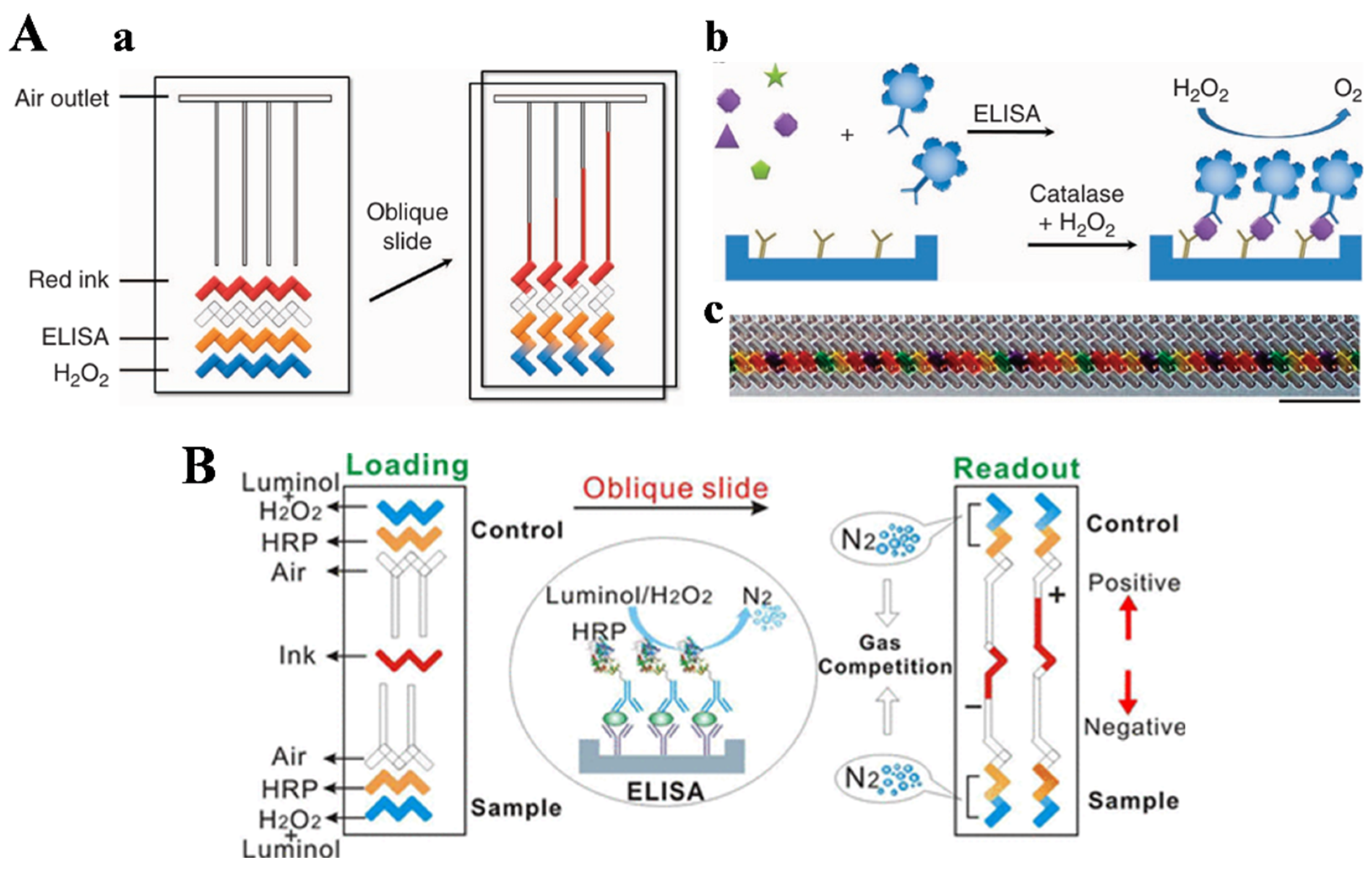
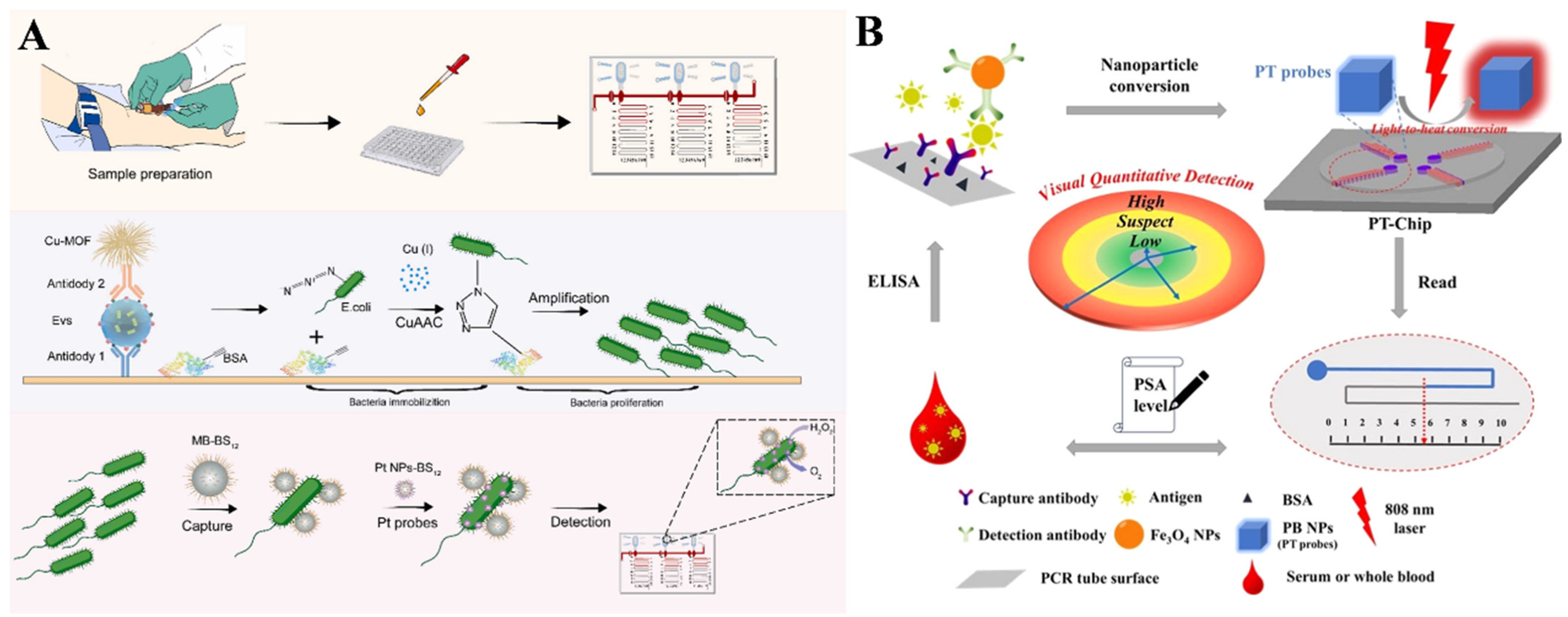
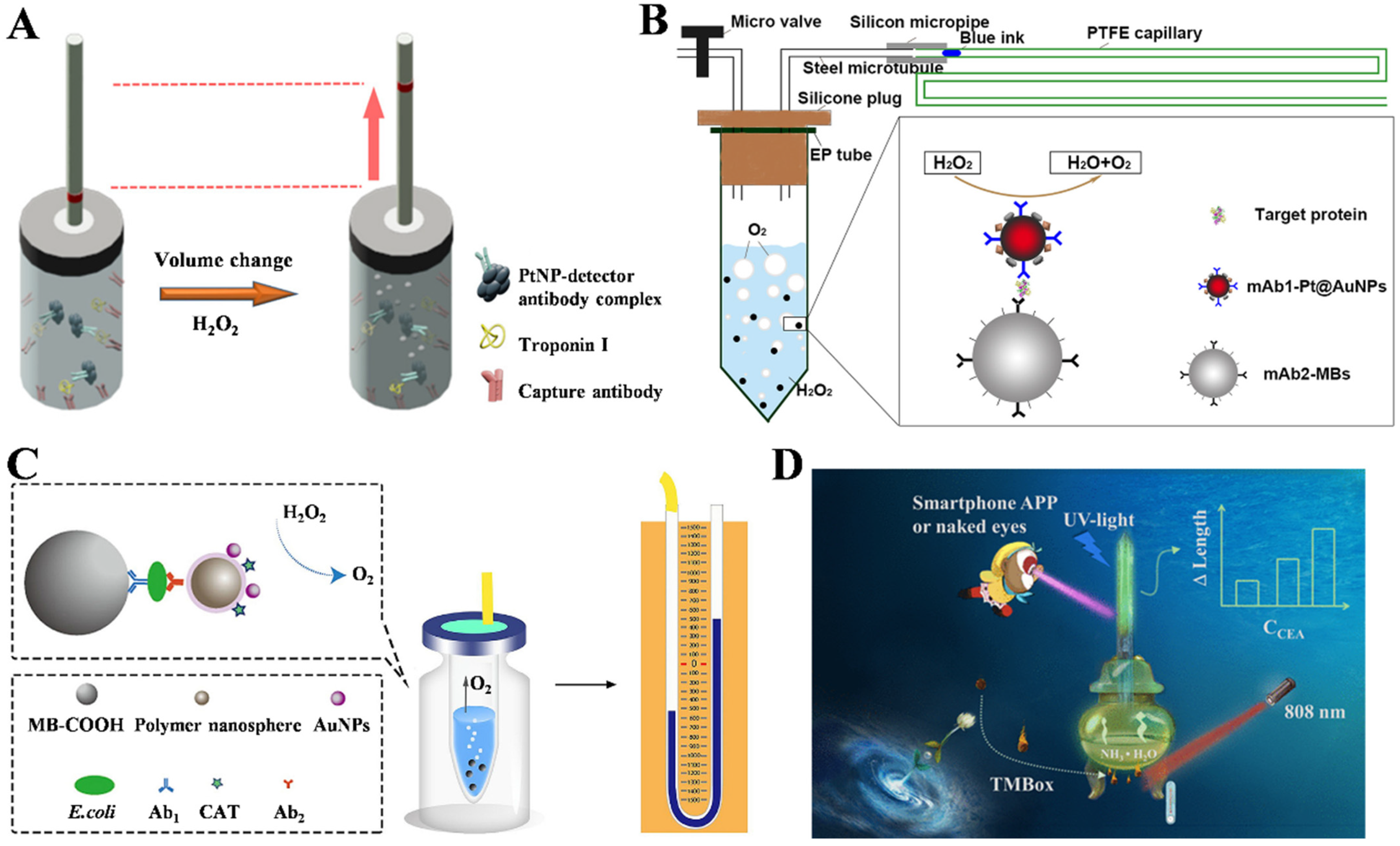


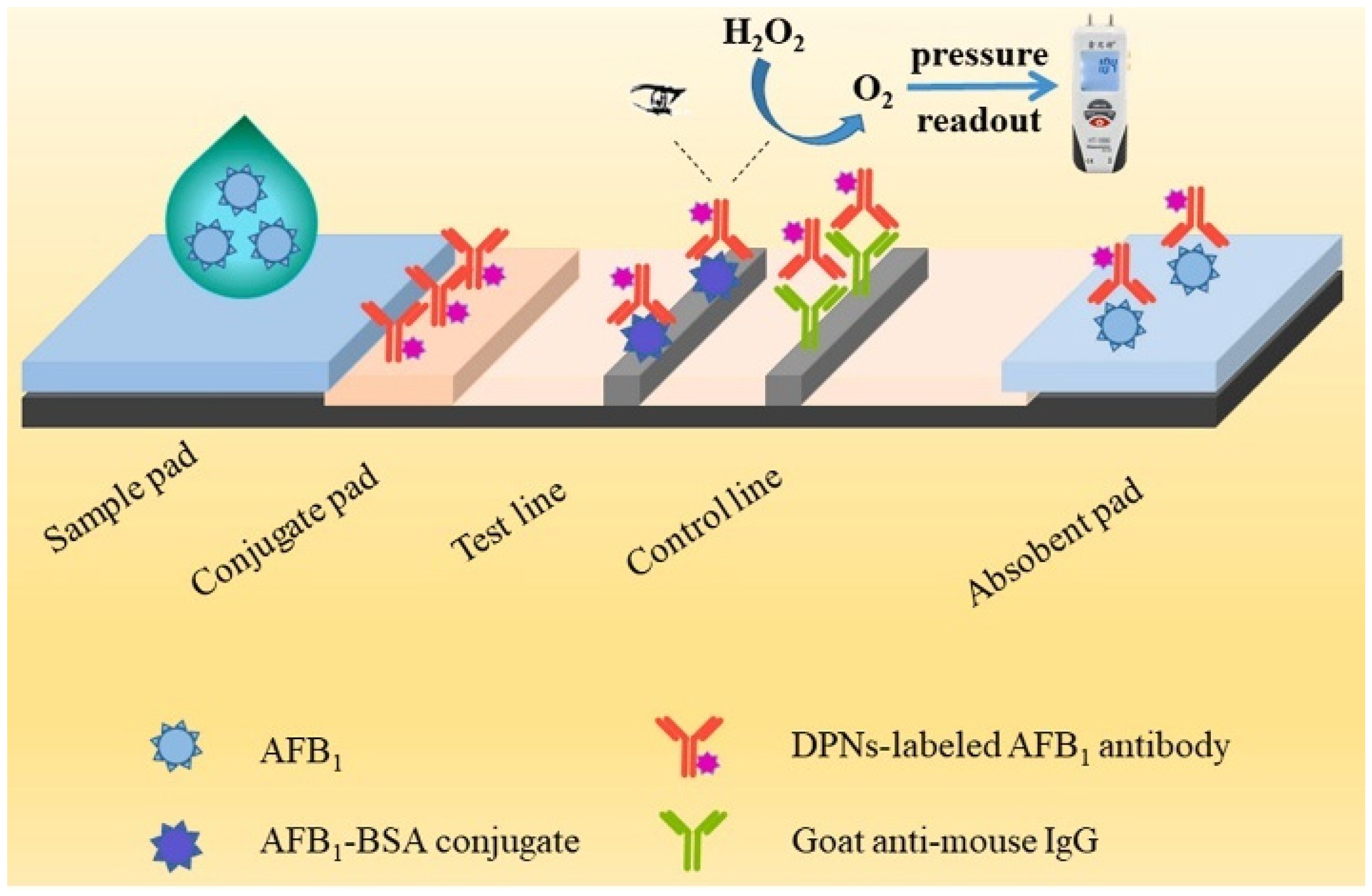
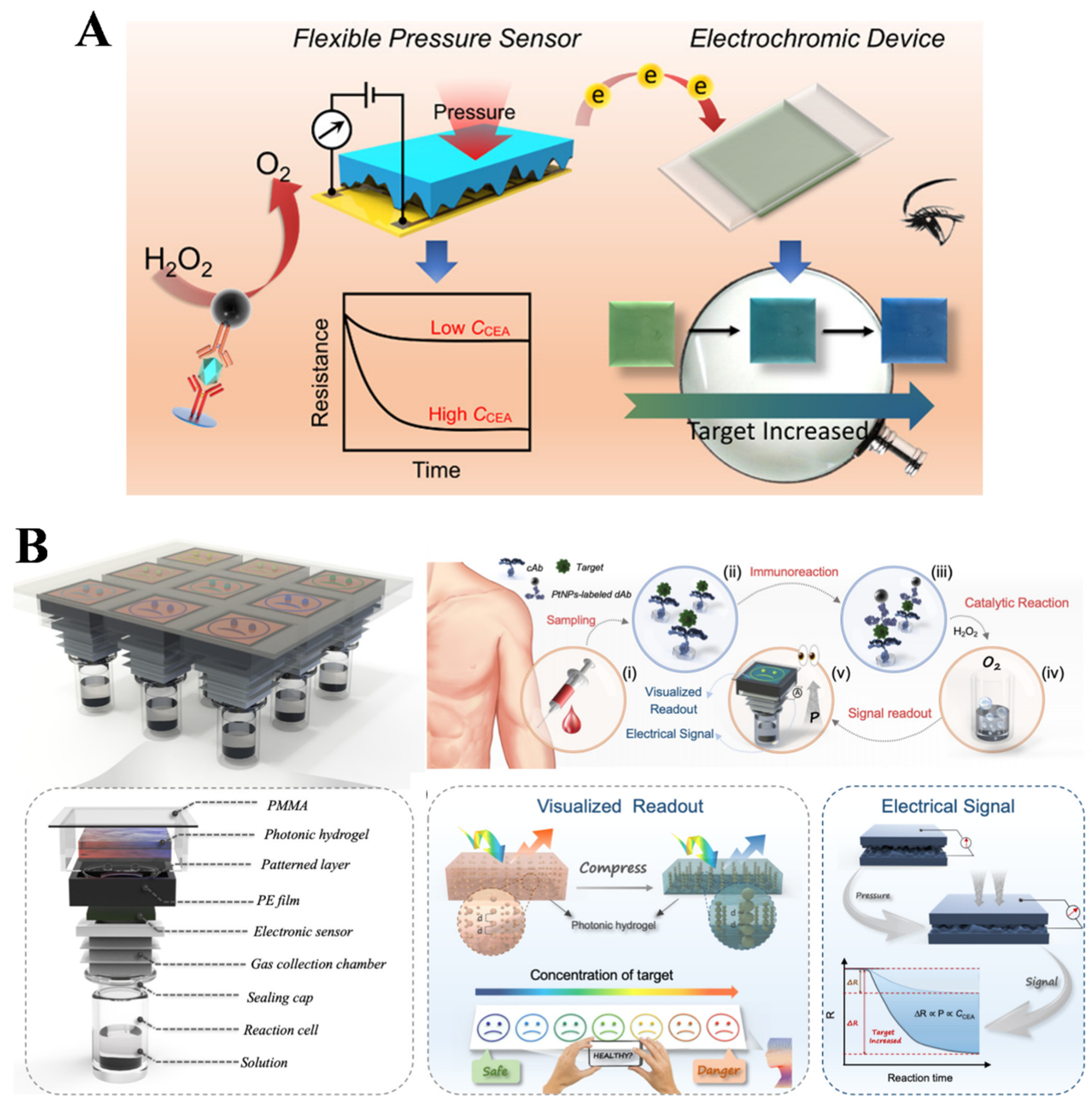
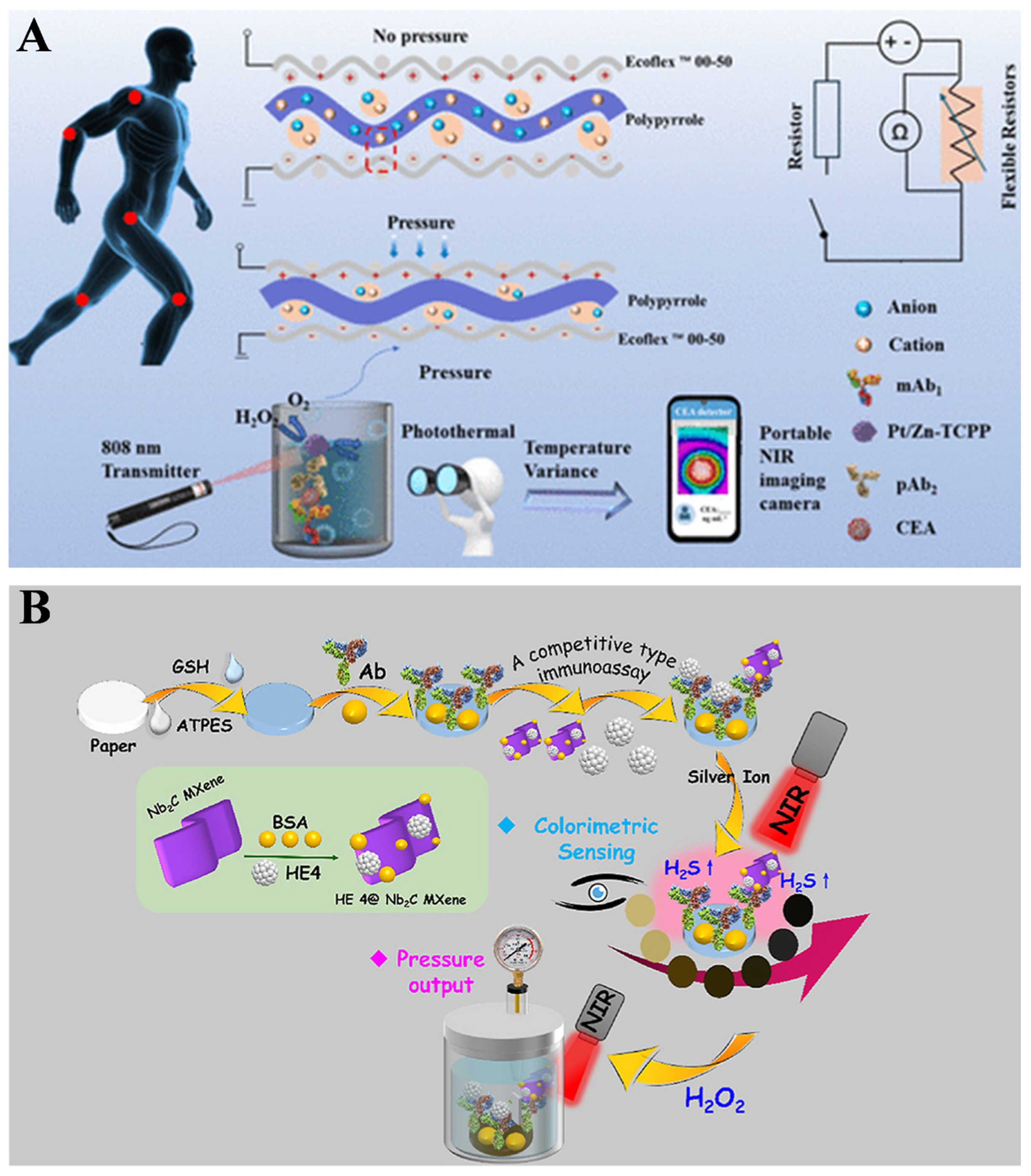

| Signal Label | Target | Linear Range | Detection Limit | Ref. |
|---|---|---|---|---|
| PtNPs | CEA | 0.2−50 ng/mL | 94 pg/mL | [118] |
| PtNPs | CEA | 0.3−60 ng/mL | 0.13 ng/mL | [119] |
| Pt/Zn-TCPP | CEA | 0.5–100 ng/mL | 0.24 ng/mL | [120] |
| Fe2O3 particles | CRP | 0.75–12 μg/mL | 0.45 μg/mL | [121] |
| Nb2C MXene/Ag-Sx | HE4 | 10−7–0.1 ng/mL | 3.01 × 10−7 ng/mL | [122] |
| Fe-MOF/PtNPs | Salmonella | 1–107 CFU/mL | 93 CFU/mL | [123] |
Disclaimer/Publisher’s Note: The statements, opinions and data contained in all publications are solely those of the individual author(s) and contributor(s) and not of MDPI and/or the editor(s). MDPI and/or the editor(s) disclaim responsibility for any injury to people or property resulting from any ideas, methods, instructions or products referred to in the content. |
© 2024 by the authors. Licensee MDPI, Basel, Switzerland. This article is an open access article distributed under the terms and conditions of the Creative Commons Attribution (CC BY) license (https://creativecommons.org/licenses/by/4.0/).
Share and Cite
Yu, Z.-J.; Deng, D.-H.; Liang, S.-R.; Huang, Y.-L.; Yi, X.-Y. Overview of Gas-Generating-Reaction-Based Immunoassays. Biosensors 2024, 14, 580. https://doi.org/10.3390/bios14120580
Yu Z-J, Deng D-H, Liang S-R, Huang Y-L, Yi X-Y. Overview of Gas-Generating-Reaction-Based Immunoassays. Biosensors. 2024; 14(12):580. https://doi.org/10.3390/bios14120580
Chicago/Turabian StyleYu, Zhao-Jiang, De-Hua Deng, Si-Rui Liang, Ya-Liang Huang, and Xin-Yao Yi. 2024. "Overview of Gas-Generating-Reaction-Based Immunoassays" Biosensors 14, no. 12: 580. https://doi.org/10.3390/bios14120580
APA StyleYu, Z.-J., Deng, D.-H., Liang, S.-R., Huang, Y.-L., & Yi, X.-Y. (2024). Overview of Gas-Generating-Reaction-Based Immunoassays. Biosensors, 14(12), 580. https://doi.org/10.3390/bios14120580






